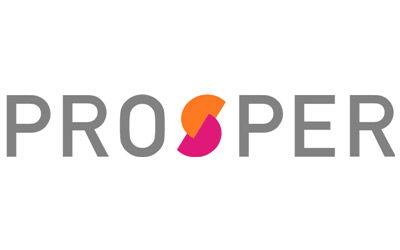New to peer-to-peer lending? It’s a type of lending that has been around for over 15 years in the U.S. and has continued to grow in that time. It’s a way for borrowers to access competitive rates outside the traditional bank lending model.

It also brings the potential for higher returns to individual investors, often even including those who are non-accredited. P2P lending is a platform meant to cut out the middleman and generally democratize the loan landscape.
On top of that, there are reputable lenders across industries. That means better diversification among unsecured personal loans, business loans, and even commercial real estate projects.
Let’s jump in and find out how peer-to-peer lending works and who are the best P2P lenders out there today.
How does peer-to-peer lending work?
Peer-to-peer (P2P) lending takes online lending to the next level, directly pairing lenders and borrowers in a virtual platform. It’s a unique alternative to traditional banking and frequently comes with lower interest rates for borrowers and higher yields for investors.
Peer-to-peer lending cuts out many of the costs typically associated with taking out loans through a bank. There are no physical branches to support, and staffing is generally a much less substantial expense for P2P lending companies.
How does the peer-to-peer lending process differ from bank lending?
Peer-to-Peer Lending Application Process
From the borrower’s perspective, the application process starts much of the same way as any other loan process. Most peer-to-peer lending platforms allow for prequalification that only requires a soft credit pull. This gives you an idea of what kind of personal loan you could qualify for and with what terms. At this point, the lending platform gives you a loan grade, which classifies your application as a risk rating.
Next, your funding request is posted on the P2P lending platform. Investors can review the details of your inquiry, such as what you’ll use your loan funds for, non-identifying aspects of your application, and their anticipated return. If interested, the investor can then commit any amount of funds to your personal loan. Once you reach a certain percentage of committed funding, your loan application moves onto the next level.
Other Peer-to-Peer Lending Requirements
You’ll need to submit information to verify your application, like proof of income and any other documentation required by the lender. It then goes to underwriting and you’ll receive an official loan agreement. The agreement will outline the details of the loan, including rates, terms, and your repayment responsibilities.
After you sign and submit the loan agreement, the loan funds are typically deposited into your bank account within 24 to 48 hours.
Borrowing through P2P Lending Platforms
Because there are extra steps involved in the approval process for a P2P loan, it can take longer to get your funding when compared to traditional lenders. However, borrowers can often qualify for more competitive rates and terms.
The upfront transparency of each borrower’s credit rating offers low credit borrowers a chance to qualify for a loan, even if traditional financial institutions have denied them.
Peer-to-peer lending platforms also offer a wide degree of flexibility on loan use. They’re all different. However, most typically allow for common funding purposes such as debt consolidation, home improvements, life events, and other significant purchases. Of course, your exact need could influence which P2P lender you ultimately choose.
Investing through P2P Lending Platforms
Investors are regularly drawn to peer-to-peer lending platforms for the pure fact that returns are often higher than other investment choices. Plus, you get to administer as much control as you’d like when managing your portfolio. That’s because you can choose how much you invest at any given moment, in addition to what mix of loan grades you want in your portfolio.
Alternatively, you’re also able to set your investments on autopilot with most of them. You typically can input how you’d like your investments to be distributed. The peer-to-peer lending platform will then automatically disburse your funds to loan requests that meet your criteria.
This frees you up from having to manually review borrower requests, making the process as simple as you want it to be. While P2P lending certainly contains a significant degree of risk, some investors may decide to make it a part of their portfolios.
Which peer-to-peer lender is the best?
There are several reputable peer-to-peer lenders online today. Here is a breakdown of the best ones to help you select the right one, whether you’re interested in borrowing or investing.
Prosper
Prosper is one of the largest P2P lenders, facilitating $13 billion in loan transactions. That’s a huge amount, and they rely heavily on large institutional investors in addition to individuals who back loans for borrowers.
LendingClub
LendingClub is another major player in the P2P space, helping clients borrow more than $85 billion over the years. The online lender advertises a quick funding process with cash available within as few as seven days.
Upstart
Upstart offers a wide variety of loan options, which is probably why it’s experiencing such enormous growth as a lender.
Fundrise – Real Estate Platform
Fundrise is another P2P real estate platform that gives individual investors access to multimillion-dollar projects. The investment horizon for each project is usually between three and seven years.
PeerStreet – Real Estate Loans
PeerStreet allows investors to finance short-term real estate loans. According to PeerStreet, their investments could be less volatile than the stock market. Investors select first lien real estate loans that are highly vetted before being offered.
How to Earn Money with P2P Lending
There are no guarantees of how much money you can make investing in P2P lending. It depends on many variables, including your risk tolerance, the type of loan you choose, and even the economy. However, some of them advertise the potential for double-digit returns. Most at least say they outperform the stock market while also being less volatile.
P2P lending platforms generally offer investor materials that you can review to get more details on the risk versus return. However, to help increase your returns, you can consider some general advice. First, think about diversification in relation to your broader portfolio and your P2P portfolio.
You probably don’t want to invest solely in high-risk, high-yield loans. Try investing enough money so that you can spread the money over different loan grades.
How to Compare Peer-to-Peer Lenders
When looking for a peer to peer loan, it’s a good idea to take an in-depth look at multiple lenders. In addition to that, it also helps to have an overview of what makes a good loan offer. Just like traditional loans, when comparing personal loans from peer-to-peer lenders, there are numerous factors to consider:
- APR: This is the total cost you pay to borrow money, including interest rates and fees. The higher the rate, the more you’ll pay. Both traditional lenders and online lenders will look at your credit score, income, debt history, and selected loan term to determine interest rates.
- Loan Term: This refers to how long you have to repay the loan. A shorter-term will mean a higher monthly payment, but the offset of that is a lower interest rate and thus, a cheaper loan overall.
- Origination Fee: An origination fee is charged by some lenders to cover the cost of processing the loan application. Usually, this is no more than 1% of the total loan amount.
- Prepayment Penalties: Some lenders charge prepayment penalties if you pay off your loan sooner than is stated in the loan agreement. If you want to avoid this sort of fee, make sure to read the fine print before signing any agreements.
- Collateral: If you have less-than-perfect credit, some personal loan lenders may offer secured loans. This means that property such as a house or car is used as collateral for the loan, making borrowing to you less risky for the lender. A secured loan can be easier to qualify for, and should come with a better interest rate.
Frequently Asked Questions
Can you get peer-to-peer loans with bad credit?
Just as it is with traditional financial institutions, getting a peer to peer loan with bad credit can be difficult. In fact, it might even be harder to find a peer to peer lender if your credit history is poor or thin. That’s because most lenders won’t be interested in taking a chance on someone with a low credit score.
If you’re looking to borrow money with a peer to peer loan, you’ll want to have a FICO credit score of at least 600 – 640.
What do I need to find a good peer-to-peer lender?
In addition to a good credit score, there are a few other details that will determine how easy it will be for you to find the best peer to peer loans:
- Credit History: If you’ve got thin or non-existent credit history, benefiting from P2P personal loans will be next to impossible. Lenders primarily determine eligibility via credit scores, and will always look to users with good or excellent credit.
- Debt: If your debt-to-income ratio is out of balance, you will likely struggle to find a P2P personal loan.
- Employment History: When applying for a P2P personal loan, lenders will usually check your employment history. If you’re currently unemployed or have been for a large period previously, that can also weigh against your favor.
Is peer-to-peer lending safe?
Just like your returns rely on several factors, so does your safety as an investor choosing peer-to-peer loans. Your funds aren’t insured, but all P2P lending platforms must register with the SEC. This keeps them under federal scrutiny to ensure they stay in practice with all the current regulations.
Still, diversity must be a priority in minimizing your risk when investing in these types of loans. For example, if a borrower defaults on a loan you’ve invested in, you’ll lose that money. So be sure to create a healthy balance within your accounts.
You can also start conservatively as you learn the process, then add in higher yield loans to bolster your returns. It’s also essential to check out the peer-to-peer lending platform’s vetting process for its borrowers.
Bottom Line
Whether you’re interested in borrowing or investing in a P2P loan, there are countless options available today. Peer-to-peer lending platforms have made personal loans, business loans, and real estate investments more accessible to all parties.
As with any financial decision, the key is to do your research and compare options. Each P2P lending company has its strengths and weaknesses. So do some digging to figure out which one best meets your needs for either funding or investing. Once you find it, it’s a win-win for everyone.









